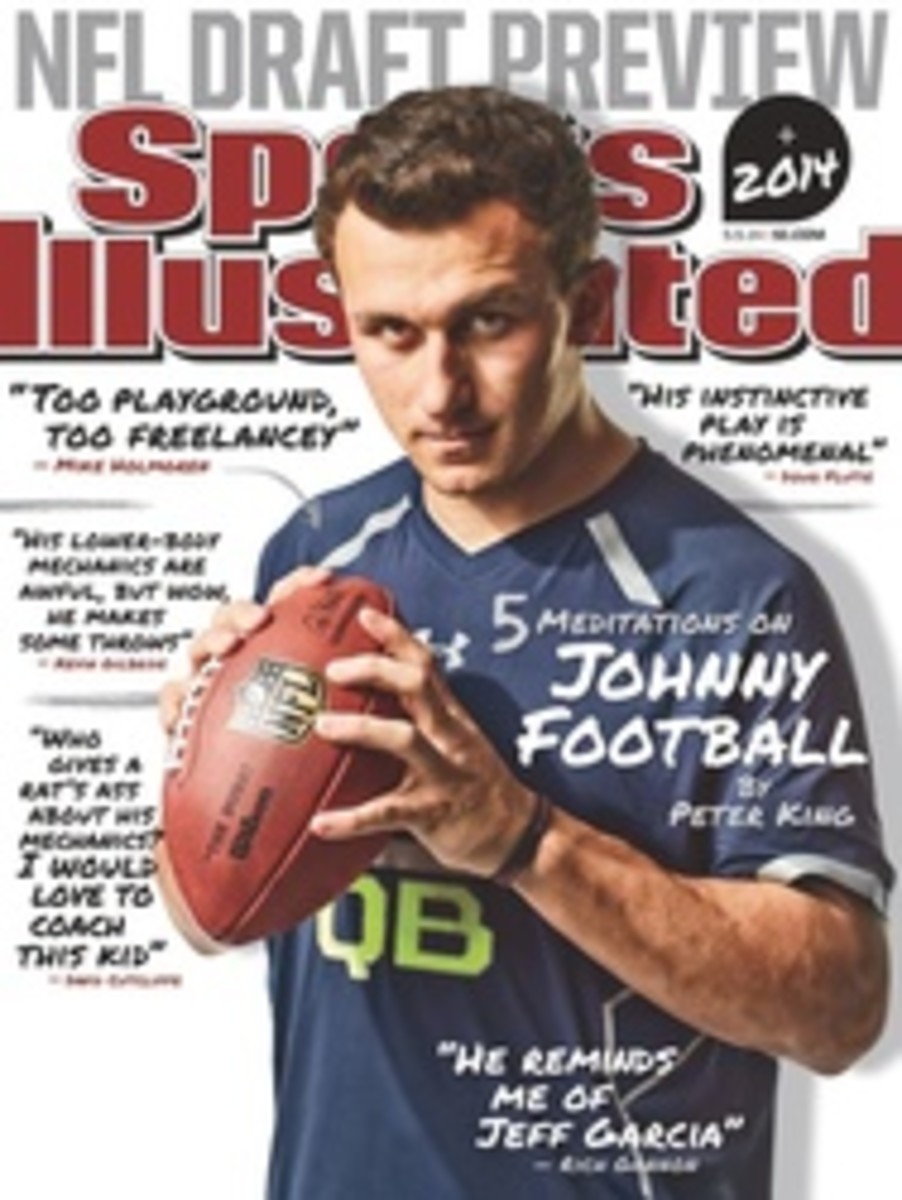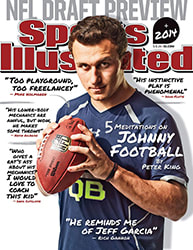
The Greatest
IT'S NO exaggeration to say that every sportswriter of a certain ambition and age—let's say from 20 to 70—has had a Gary Smith moment. This is not fun. What starts as excitement soon becomes a swirl of puzzlement, awe and surprise; the frantic fluttering of pages forward and back; the parsing of sentences like so much Kremlinalia; some involuntary, half-baked blurts like, "How did he... ?" and "Why did no one else... ?"—and all of it leads back to you, you sorry bastard, and how you're never, ever going to write a story like that, so what were you thinking getting into this business in the first place?
Since youth is the time of prime vulnerability, such a moment always hit fresh-faced Hemingways the hardest. Mine came at 23, when Smith's cover story in the Nov. 18, 1985, issue of SI began like this:
When Dale Brown was nine years old, he set fire to the building where he worked. He didn't mean to. Something he didn't understand drove him to strike a match in the furniture warehouse and light the piece of straw sticking out from the leg of a chair. It made him feel fearless and free. Suddenly the chair was in flames and the feeling was gone. He raced into the street unnoticed, up the stairs to the family apartment just a few doors away, and into the bathroom.
He pulled down his pants, sat on the toilet and put his head in his hands, heart hammering, each scream of the sirens....
Now, I don't know about anyone else.... Wait. I do actually. In the Smith canon—and he's one of the few who could claim such a term without being tweeted down as a self-promoting hack—Smith's portrait of the former LSU basketball coach is considered second-tier; he was still learning then. No, for most peers and SI readers, it's likely his story about Crow Indian basketball or former Notre Dame football coach George O'Leary or fallen basketball star Richie Parker or a TCU football photo—all winners of the National Magazine Award—or his take on a basketball coach in Amish country ... or Muhammad Ali's entourage ... or Mike Tyson or Jim Valvano or Mia Hamm that left them astonished, teary and yet elated that a mere sports story could move them so.
Still, you don't get to choose the arrow that pierces your heart, and Hello, Trouble, I'm Dale Brown was mine. I was a newly minted writer on the Sacramento Kings beat for The Bee, and just beginning to understand that my glum head coach, Phil Johnson, was determined to never utter an insightful word about his sandwich, much less himself. And now here's Coach Brown telling Gary Smith revealing, startling, damning facts that he'd never told another reporter, here was psychological depth you found only in fiction. Somewhere in the space between "fire" and "toilet," I'd been hooked like a wriggling pike and had no choice but to put life on hold until I'd read each word.
"What happens to us?" Brown says, in the story's final lines. "My God, what happens to us?"
That, in short, was the essential Gary Smith question, asked in these pages for 32 years, and his relentless pursuit of an answer made him not only the most revered sportswriter in America, but also the most decorated magazine writer, ever.
Smith's 13 selections in The Best American Sports Writing is a record, as are his four National Magazine Awards. When he won his first, in 1992, for Shadow of a Nation, he beat a stunning piece written for LIFE—by Gary Smith. All too often the man was competing only with himself.
Smith, 60, has decided to retire from SI and magazine writing, to focus perhaps on books or something entirely different. For the last six years he has taken to going, once or twice a year, on a silent retreat. "Just figuring out how the mind works," Smith says. "Turn the lamp inward and watch the mind and what it does. We're just a piece of the universe, and you can start to get a glimpse of how it all works if you can get the mind quiet and still enough."
If that thought is a bit too mystical, too Zen, for those whose idea of sportswriters was formed by Oscar Madison and Ray Romano, understand that it's nothing new. Though he cut his teeth on the savage Philly preps beat and covered Dick Vermeil's Eagles for the Philadelphia Daily News, Smith's uncanny ability to relate to the most foreign milieu, the worst malcontent, emerged unscathed. And once he gained their trust, once he sunk those teeth in, he did not let go.
Legend has it that Smith would interview at least 100 people before he'd even start to write: Not true. But there were days spent questioning the likes of Andre Agassi and John Damned Yankee Malangone, hours upon hours of questions about fathers, brothers, smells and ills and habits and joys. "I really exhausted some people along the road," Smith says, "because I need to understand this person as completely as I possibly can. Because to connect all the dots and make sense of who this person is and why they interface with the world the way they do, I need to know everything. As much as humanly possible, I wanted to know it all."
He had his misses. He had his critics. Some were uncomfortable with Smith's psychologizing—though his subjects almost never claimed that he got them wrong—and others wondered if the personal demons he detailed could explain an entire life's twists and turns. But that's a shallow reading; Smith, indeed, found trauma others missed. But there's a reason the question mark, not the period, is his distinctive grammatical tic. He pursued answers but was delighted to find them less than clear.
Smith had little interest in painting Mike Tyson or Allen Iverson as pure villains or Dean Smith as a pure hero. He knew better. His great achievement was an inversion of sport's central allure—the way it reduces messy existence to clear winners and losers, good guys and bad guys. He made it O.K. to feel uncertain about the athletes we were sure we knew, to empathize more than judge, to end a story feeling more conflicted than consoled. Because at gut level we understand: No human is ever as simple as a ball game.
"At a certain point that paradox and ambiguity became the gold mine," Smith says. "A lot of journalists shy away from, or fall into the he-said, she-said approach, to deal with that ambiguity and paradox and contradiction, but if you take it all on and realize that's where the treasure is, ultimately readers are going to respond. Because, I think, everyone in their inner life senses that's how it really is."
Smith, better than anyone, used sports as a cultural mirror. His masterpiece—for my money, anyway—was the Parker story, Crime and Punishment (June 24, 1996), which shows how the recruitment of a tainted basketball star forever altered the lives of 12 confounded people. It offered no pat solutions for player, reader or one very smart college president, but it captured better than any book, film or NCAA brief our troubled relationship with fun and games.
All this confusion, does it signal a society lost in the wilderness ... or one finally mature enough to look at questions it has always shut its eyes to? His mind gnaws at the bone, at every last bit of gristle. Beneath it all, he can sense what's going on, the vague feeling that people are beginning to have that their love of sports—the sense of escape and belonging that they provide—is doubling back on them like some hidden undertow, pulling them out to sea.
That was written 14 years after Gary Smith first announced himself. Yet his words had that same effect and would for 18 years more: Each time you saw him do what no one else does, saw the possibilities available in a story about mere sports, the words softened you up, and his piercing arrow flew, and you knew it was a small miracle—of journalism, of craftsmanship, of timing and talent—that they'd ever been written at all.
"I really exhausted some people," Smith says, "because to make sense of who this person is, I need to know everything."
Baseball
Top Cards
20
Extra Mustard
22
SI Edge
Klay Thompson
24
Faces in the Crowd
26
Dan Patrick
Jabari Parker
28
The Case for
Horse Racing
30
GO FIGURE
22/3
No-hit innings pitched by the Blue Jays' Brandon Morrow when he was pulled from a game last Saturday. He'd walked eight of the 14 Red Sox he'd faced and given up four earned runs.
$14,100
Price of a hand-stitched calfskin baseball mitt introduced by the French couture company Hermès. Each one takes 25 hours to produce. If a buyer isn't sure what to do with any leftover change, the company offers a matching bat for $1,925.
10,127
Entries accepted by the USGA for U.S. Open qualifying, breaking the record of 9,860 set last year. Those advancing through local and sectional qualifiers will play in the Open on June 12--15 at Pinehurst No. 2 in North Carolina.
102
Age of Connie Marrero, the oldest living former major leaguer, who pitched for the Senators from 1950 through '54, at the time of his death last week at his home in Havana.
300,000
Stickers depicting World Cup players that were stolen from a delivery van in Rio de Janeiro last week. The theft set off a minor panic among collectors who strive to acquire a full set of the 640 stickers.
Trade School
Unlike traditional cardboard baseball cards, digital cards update stats in real time and allow Topps to track collectors' trades through its new Bunt 2014 app. Despite reports that the company sold more digital cards in the last year than the total of cardboard cards sold since it started in 1951, the company says it has never released the number of traditional packs it has sold. The company confirms, however, that more than 80,000 trade offers are made in the app every day. So which digital cards are mentioned in the most trade offers?
Five Most Wanted
1. Masahiro Tanaka GOLD
2. Mike Trout SIGNATURE
3. David Wright BOOST
4. Hank Aaron GOLDEN MOMENTS
5. Ozzie Smith THROWBACK THURSDAY
PHOTO
LANE STEWART/SPORTS ILLUSTRATED
PHOTO
FRANK GUNN/THE CANADIAN PRESS/AP (MORROW)
PHOTO
HERMÈS (GLOVE)
PHOTO
EPA/LANDOV (MARRERO)
PHOTO
PANINI/CLICKDISTRIBUTION.CO.UK (STICKERS)
PHOTO
CHRIS RYAN/CAIAIMAGES/GETTY IMAGES (GOLF BALL)
PHOTO
COURTESY OF TOPPS (CARD)

